

© Shipping Wonders of the World 2012-

The Mighty Amazon
South America’s great waterway with its many tributaries is a strange and remarkable ocean highway that leads to the heart of a continent
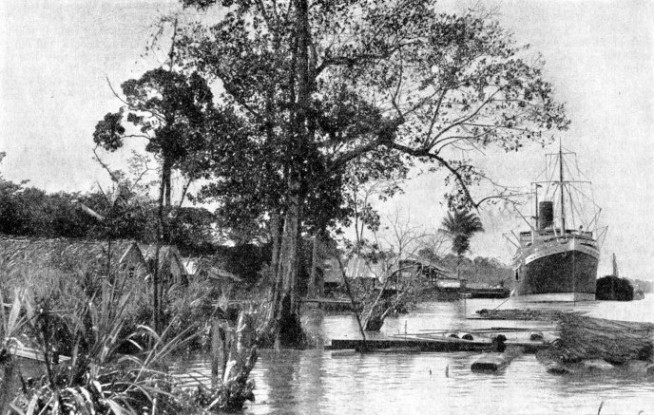
The Booth Line ship the Hilary on the River Amazon
THE great system of waterways in South America called the River Amazon, or Amazonas, drains an area of 2,722,000 square miles, which is nearly as large as Australia. For thousands of miles the river and its great tributaries form an ocean highway that leads into the heart of a continent. The river flows from the foot of the Andes mountains, the western backbone of the continent, and then winds its way eastward to the Atlantic Ocean. It enters the Atlantic at the equator.
A passenger in search of an unusual holiday can step aboard a liner at Liverpool, be carried across the Atlantic and about a thousand miles up the Amazon to Manaos, and return to Liverpool in the same ship, He can enjoy all the comforts of modern sea-
upon each other as they have done for thousands of years dwell in the tangle of forests, protected from the questing white man by the green wilderness. Of all great rivers the Amazon is the most inscrutable. To venture far from the river banks into parts of the forest is to court death that may come silently from the blow-
Except for a railway near Para, at the mouth of the Para River, and another line avoiding the rapids on the Madeira River and so forming a link in the river communication, rail transport is unknown in this vast region.
So intricate is the network of waterways that the total length of water communication has been computed at 45,000 miles. Only part of this network -
The first man to get down the river from the Andes to the Atlantic was Francisco de Orellana, who made one of the most wonderful river voyages ever recorded. He was second in command of an expedition, the chief of which was Gonzalo Pizarro, younger brother of the conquerer of the Incas. There were stories of a land of cinnamon; and Pizarro set out from Quito, now the capital of Ecuador, on Christmas Day, 1539, to find it. Many of the Indians with the expedition froze to death in the mountains, but the party struggled on. They passed through a country where for two months the rain did not stop for a single day, and arrived at the Napo River. Pizarro built a vessel and the Spaniards followed the river, some in the little ship and others in canoes or along the banks. Then they heard of a land rich in gold and food, and Orellana went ahead in the ship with orders to load her with food and return to relieve the starving men. But Orellana found no provisions when he reached the place. He did not return and afterwards said it was impossible because of the current. Pizarro struggled back to Quito. He arrived there with only a remnant of his forces. Orellana was in a desperate plight. The men ate the skins which formed their girdles, and boiled their shoes for food. They had given up hope, when they heard Indian drums and came to a village where the natives were ready to fight them. The famished men landed, drove off the Indians and ate all the food they could find. Some of the Indians returned and saw that all the strangers wanted was food. Peace was made and Orellana at once decided to build another vessel and to abandon the canoes. They had no nails, but two men made 2,000 in twenty days, while others fashioned a “brigantine”. When she was finished they embarked.
Fighting for Food
After having floated a great distance through uninhabited forest they came to a place where they were attacked by thousands of Indians, some in canoes and some on land. Orellana sent a raiding party ashore. They entered a village, seized food and fought their way back to the ships through 2,000 Indians, while the men in the two ships beat off attack after attack. The Indians followed the Spaniards downstream, harrying them. In vain the Spaniards landed on an island to eat and rest; the Indians attacked again. Taking to the ships the Spaniards weighed, followed by over a hundred canoes, and did not stop for two days until they had outdistanced the canoes. They took possession of a village, where they rested.
Sometimes obtaining food by barter and sometimes by fighting,the Spaniards passed the confluence of the Amazon and the Negro River. Lower down there was more severe fighting. Father Carbajal, the chronicler of the voyage, said he saw ten or twelve women warriors fighting in front of the Indians as if they commanded the men, and these Amazons killed seven or eight Spaniards with their arrows. In one skirmish the Father was blinded in one eye by an arrow. Some of his stories seem exaggerated, especially one of a bird which followed the voyagers for a thousand leagues and always called out huis, meaning houses, when they were nearing a village.
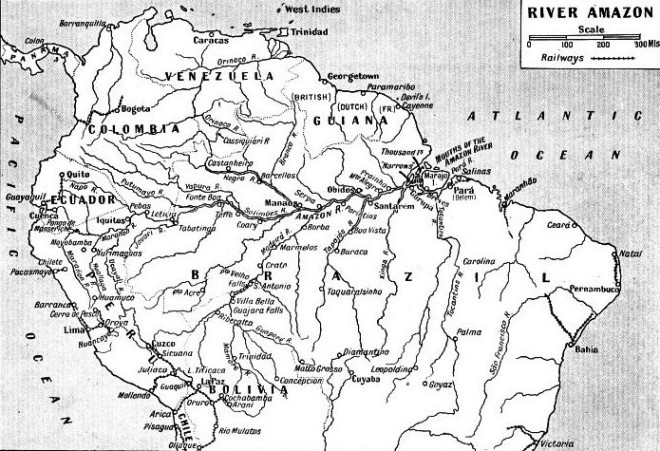
THE RIVER AMAZON DRAINS AN AREA of 2,722,000 square miles, or an area nearly as large as Australia. It has been computed that the total length of water communication is 45,000 miles. Only about 6,003 miles of this are available for ocean steamships, but shallow draught steam launches, boats, canoes and rafts can penetrate into the heart of South America.
At last the Spaniards came to tidal water, but the smaller vessel sank, and the larger was stranded. Half the men had to raise one vessel and refloat the other, while the other half beat off a party of attacking Indians. The Spaniards repaired the vessels, sewed blankets together for sails, made rigging and ropes out of grass, and put to sea, both vessels reaching the West Indies in September, 1541.
The next expedition from the Andes to the Atlantic set out from Lima, Peru, under Pedro de Ursua, in quest of El Dorado. This expedition reached the Huallaga, one of the headwaters of the Amazon, in 1560. The men mutinied and murdered de Ursua. Fernando de Guzman succeeded him but was deposed by Lope de Aguirre. The mutineers probably left the Amazon at its confluence with the Negro and went up that river to the Orinoco and so to Venezuela, where Aguirre was shot as a traitor by the authorities.
Seven men, including two Franciscan lay brothers, sailed down the Napo and the Amazon from Peru and reached the new Portuguese settlement at Para in 1637. The Portuguese governor determined that Portuguese should be the first to go up the river, and immediately sent an expedition under Pedro Teixeira. The explorer reached Quito in 1638, to the astonishment of the Spaniards, who ordered him to return by the way he had come and to take two Spanish priests to survey the river. Teixeira began the return journey in 1639 and reached Para at the end of the year. One of the priests, de Acuna, wrote an account of the trip.
Missionaries, the most famous of whom was Father Samuel Fritz, explored the great river. Fritz spent thirty-
Alexander von Humboldt added greatly to the knowledge of the river and proved the connexion between the Amazon and the Orinoco by the natural canal called the Cassiquiare. At a much later date Dr. Hamilton Rice made a number of expeditions to the Amazon. Colonel Fawcett went into the Amazonian forest in 1925 in search of a strange tribe -
Para, the ocean port of this vast waterway, is not on the Amazon but on the Para River, which is the lower reach of the Tocantins River. The Para River connects with the Amazon by what are called the Narrows of Breves and is used by all large ships, as the mouth of the Amazon is riddled with islands and shoals.

REGULAR STEAMSHIP SERVICES are maintained between Liverpool and the Amazon by the Booth Line Ships run to Para and up the river to Manaos and between Para and New York and other ports. This photograph was taken from the Booth Line steamer Hilary. The Hilary was built in 1931 by Cammell Laird & Co. at Birkenhead. She has a gross tonnage of 7,403, an overall length of 424 ft. 3 in., a beam of 56 ft. 3 in., and a depth of 34 ft. 3 in.
Steam navigation of the Amazon began in the ’fifties of the last century, when the Brazilian Emperor authorized a Brazilian company to found a service with three small vessels. Merchant ships of all nations are allowed up the river and its branches. Para, or Belem, founded in 1615, has a population of over 250,000, is the biggest port of the Amazon, and is served by steamers from Europe and North and South America. It is the capital of the State of Para, and is the most northerly town in Brazil, being about a degree and a half south of the equator. It has been called the Paris of the Amazon, but the town had to be hacked out of the jungle by the pioneers; in fact, a piece of the forest remains in the town to form the lovely park called the Bosque. At one time Para was notorious for yellow fever, but this evil has been eradicated, and wharves for ocean and rivers steamers have been built.
The name Para, however, brings rubber rather than a seaport to mind. Para rubber was not a local product, but the name for the excellent quality of rubber shipped from the port. The palmy days of Amazonian prosperity were brought about by the demand for rubber for motor-
In the early years of the present century rubber was as valuable to the Amazon as gold has been to other places. Fortunes were made rapidly all along the great river. Seeds of the rubber plants were taken from Brazil and planted in the East by Britons. This led to the establishment of well-
An attempt to challenge the supremacy of Eastern rubber is now being made by Henry Ford, who has secured a large concession up the Tapajos River, an Amazon tributary. Boa Yista is the river port and centre of this estate of 5,000 square miles, and is a model town complete with cinema. The workers are well treated.
During the boom the Amazon attracted white men from all parts of the world. Some knew nothing of the country when they came upstream to Manaos and were transhipped into river steamers for the journey to the rubber-
They were unable to get away unless they had the fare back to civilization, and were thus prisoners in the forest. Other men, outcasts from civilization, turned the tables on the proprietors. They deliberately got into debt with their employers and then stole all they could and went by raft or boat to another part of the country. There, if they could not get employment, they formed gangs of bandits. Sometimes a scoundrel would capture several Indians and take them to another district where he would sell them as slaves. Then came the day when rubber sent down the river could not be sold at a profit because of the competition from the East. The relentless pressure of economics crippled the Amazon trade from the inland ports to the sea.
The greater part of the Amazon is remarkably level, and the slope from the Andes to the Atlantic is only 250 feet, although some of the tributaries come down from higher ground and are interrupted by rapids. The most famous rapid (pongo) is the Pongo de Manseriche, where the Maranon River has worn a 2,000-
Another feature of the river is that it has no delta of alluvial mud encroaching upon the sea, but is losing ground despite the amount of mud in the water. The enormous volume of water stains the blue of the Atlantic with a yellow tint many miles from the mouth, and the tides at the entrance are complicated. They run swiftly. On the northern side the incoming tide becomes a bore, or pororoca, at certain seasons, and comes booming in at a speed of nearly fifteen miles an hour. The wall of water rises to a height of 12 feet, and the roar it makes can be heard for miles.
At the mouth, the large island of Marajo (about the size of Belgium) divides the rivers Amazon and Tocantins, and the lower reach of the latter, between the island and the mainland, is called the Para River. Although there are channels leading in from the sea, these are too shallow and intricate for large ships. As there is no city of importance to attract the river passenger-
Regular services from Liverpool to Para and up the river to Manaos, and between Para and New York and other ports are maintained by ships of the Booth Line. The vessels are all modern. The Hilary, 7,500 tons register, has been designed to carry tourists on one of the most remarkable of all voyages. In the northern winter, when passengers are anxious to pass from the greyness of Europe to the glamorous tropics, the cruise is particularly popular. The ship is well heated for her passage through the colder waters, and her cabins are also designed to give the utmost ventilation during the voyage up the Amazon where heat, and not cold, is the problem.
To reach Para the Hilary steams up the Para River between the mainland and Marajo Island. The river route from Para to Manaos entails careful navigation, as the banks look so much alike that it is difficult to distinguish one channel from another. Every care has to be taken to avoid the swift current and to work slack water. Para has to be left at a time that will enable the ship to make the most of the flood tide. The Tocantins River, 1,600 miles long, with a mouth ten miles wide, and smaller rivers, are passed -
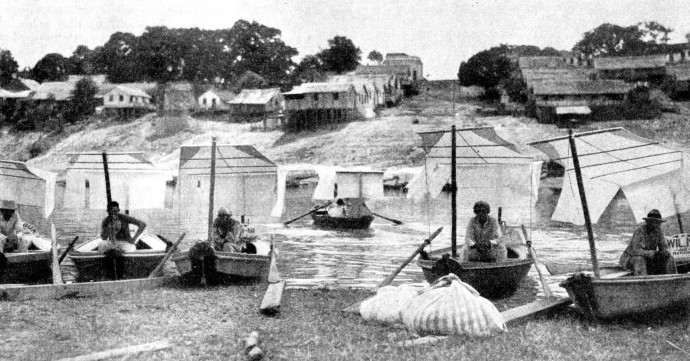
LARGE AND SMALL CRAFT can be seen during the trip up the Amazon. This picture shows some typical pleasure craft protected from the sun by a characteristic shade. Trips in small boats are made from Manaos, where the Booth Line ships stay for four or five days. One of the most popular trips from Manaos is to the famous Taruma Falls, in the heart of the neighbouring forest. A stern-
Emerging from the Narrows into the broad Amazon, the ship passes through country where the banks are steeper, one hill rising nearly 1,000 feet above the north bank. Mountains are seen near Monte Alegre. At the little town of Santarem the Tapajos River flows into the Amazon, bringing bottle-
During the rubber boom Manaos was the rendezvous of the upstream rubber gatherers, and the inhabitants concentrated on supplying the amusements likely to stop a man with well-
As the principal port in the interior of Brazil, Manaos is well equipped. To cope with the rise and fall of the river, there are five floating pontoon wharves; the depths of water in the river are about 100 feet during the high water season, and 60 feet in the low season. There is a stone wharf for small river steamers in the high season. The floating pontoon wharves are connected by aerial cableways with the stone quay, and one, used by coasters and river steamers, has a floating roadway. There are patent slips and yards for repairing river steamers.
The steamer route to Peru is not up the Negro River upon which Manaos stands, but up the Amazon, the reach above the junction with the Negro being called the Solimoes, and that above the junction with the Napo the Maranon.
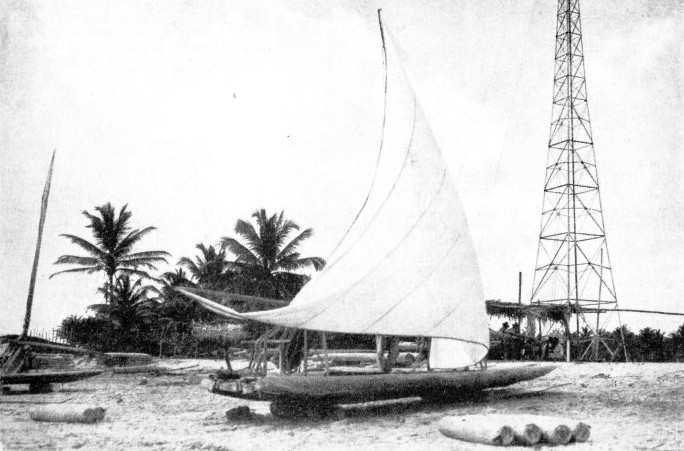
A CATAMARAN ON THE BEACH at Ceara. Ceara is the name by which this town is generally known, but it is in fact the name of the state, on the north-
On the way up the river to Iquitos the border between Brazil and Peru is reached at Tabatinga in the former country, Leticia, in Columbia, being just above it. During the rubber boom Iquitos grew to a thriving town, but when the boom was over the population shrank. Vessels discharge and load at an iron floating wharf.
The Javari River forms the boundary between Brazil and Peru for some distance and joins the Maranon opposite the frontier town of Tabatinga. It is navigable for steamers for about 260 miles and by launches for about 800 miles. The junction of the swift-
Some idea of the intricacy of the river network can be gained from the fact that no fewer than thirty rivers flow into the Putumayo during its course of about 900 miles before it joins the Maranon. The Maranon is over a mile wide and its depth more than 100
fathoms at the point below Iquitos where the Napo flows into it.
On the upper waters of the Negro there is the natural canal called the Cassiquiare. The Negro itself is a great waterway, and above Manaos it broadens into a lake-
On the southern side of the Amazon the mighty Madeira River affords a highway for ocean ships as far as Sao Antonio. Porto Velho, just below this town, is the terminus of a railway built to avoid the rapids above Sao Antonio. For some 230 miles rapids and waterfalls prevent vessels from ascending or descending. Above them the river splits into two streams, the Guapore and the Mamore, the latter being a highway for produce coming from the inland Republic of Bolivia. Sao Antonio is 1,349 nautical miles from Para, and ships from Liverpool have got thus far without mishap. Every scrap of material used to build the railway that circumvented the rapids had to be brought from the United States and Europe by ships.
So vast are the ramifications of the Amazon waterways that the whole area has not been thoroughly explored. When looking at a map of South America one must remember that the Amazon is not a narrow river but a highway for ocean-
Fish in the Amazon are said to be more varied and more numerous than in any other river. The largest fresh-
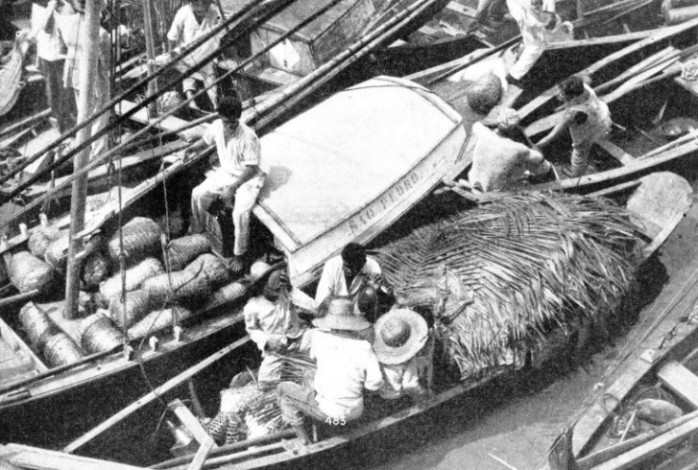
THE RIVER IS THE ONLY HIGHWAY for many of those who live on the Amazon. Patience is, therefore, a necessary virtue for the native whose livelihood depends on the river. The picture above shows native boats and their crews waiting for the low tide to leave them high and dry.
All the natives dread the piranha, an extraordinarily ferocious fish that grows to about eighteen inches long and swims in shoals. This fish likes flesh food and is attracted by any blood in the water. Wounded animals and men have been attacked by them and eaten before they could be pulled out. When these fish are seen it is dangerous to bathe, and even to put a hand into the water is to risk having it bitten off. Their powerful teeth bite through ordinary fish-
Turtles and their eggs are other articles of native food. The turtles leave the lakes when the river begins to fall and migrate upstream. The arrows and harpoons used for their hunting are ingenious. The barbed head is attached loosely to the shaft and the impact when the harpoon strikes the turtle causes the shaft to shake out and float to the surface. It is connected with the arrow barb by twine and to the harpoon barb by strong line. The turtle hunter paddles his canoe to the shaft, picks it out of the water and, if the turtle has been struck by an arrow, judges the position of the turtle by the angle of the twine. Then he takes his harpoon fitted to the head of a 12-
The strong cord that links harpoon and shaft enables him to haul the turtle into his canoe and turn it on its back. So valuable an article of food is the turtle that there are turtle farms. Captured turtles are kept in corrals and taken to sand banks where they deposit their eggs. The female waits until the male has marked out the ground and then deposits her eggs within the space selected, smoothing over the sand afterwards. A female of the larger species will lay more than a hundred eggs, each round and about as large as a golf ball. Natives generally eat the eggs raw. The hatched turtle scratches its way to the surface, but very few escape the fish which attack them when the rising water of the river floods the sand-
To catch an alligator a bait of a large piece of meat with a piece of soft wood embedded in it is used. The alligator bites through the meat, but his teeth become stuck in the soft wood: while his jaws are open he cannot dive to safety and is lasooed and killed.
The manatee, or sea-
The backwaters and lakes are inhabited by the electric eel, which kills its prey by a high-
Another unpleasant fish is the sting ray, a frequenter of shallow Water, where it lies hidden in the mud with its poisonous spike ready for action.
The river launches almost “live on the country”, as they use wood for fuel. The cost of imported coal or oil is far too high to permit of their use.
As wood is a bulky fuel, cargo and passengers are often accommodated in barges, towed by the launch or steamer.
It is more than a hundred years since the Amazon was discovered. The size of the population of the Brazilian Amazon (the state of Amazonas and Para) is unknown, but is generally reckoned to be somewhere in the neighbourhood of 500,000 to 600,000; yet, in spite of these facts it is doubtful if there are more than twenty to thirty square miles of its basin under cultivation. Commander Todd in a report of the U.S. Government said that the crying need of the Amazon valley was food for its people. He pointed out that the inhabitants of the small towns along the river are for the most part unable to obtain beef, vegetables or any kind of fruit and that they depend largely on the river fish, mandioc and canned goods.
Such is the mighty Amazon -
In one part of the park is a forest pool in which lives the manatee. There is, too, a cave in which there are hundreds of vampire bats. Outside the cave are the Assai and the bamboo, countless varieties of palms, grasses and giant forest trees. The Bosque is a striking testimony and a timely reminder of the work carried out by the pioneers who clear a way through the jungle to build cities.
In the Zoological Gardens, too, we axe reminded of the jungle. Here one may see magaws, egrets and many other Amazonian birds of brilliant plumage. Almost all types of the animals to be found in the jungle are in the gardens in cages placed among the palms. In these Gardens is a Museum of Indian Curios which include Indian war canoes, decorated burial urns from the mysterious land of Pacoval and the tombs of the Counany River.
Outside the park are the mangoe avenues of modern Para; near by, we see another contrast, that provided by the old town. Here is the market and the quayside with its queerly-
In the old town, too, is the fort which is built on the site where the Portuguese explorers first landed.
Owing to the changes in the level of the river, navigation is hazardous in the upper reaches used by launches towing other craft. Sometimes either the launch or the towed craft goes aground on a shoal, and the currents and eddies often capsize either or both
craft, and lives and property are lost. Huge rafts of timber, upon which families of natives live for months, float down-
As the season of high water in the main stream does not coincide with that of many of the tributaries the water in these rivers is kept back and floods large areas of forest.
Away from the main river the adventurous traveller proceeds by canoe into unexplored country where progress may be restricted to only a few miles a day, and, in addition to the dangers of navigating an uncharted waterway, such unexpected dangers as a poisonous snake dropping from a tree into the canoe may arise. To those with a taste for romance and adventure, the Amazon is, perhaps, the most interesting of the world’s great waterways.

BRIGHT BLUE, RED AND CHESTNUT BROWN, the sails of the fishing fleet in the Ver-
You can read more on “The Ciudad de Buenos Aires”, “The River Plate” and “World Waterways” on this website.